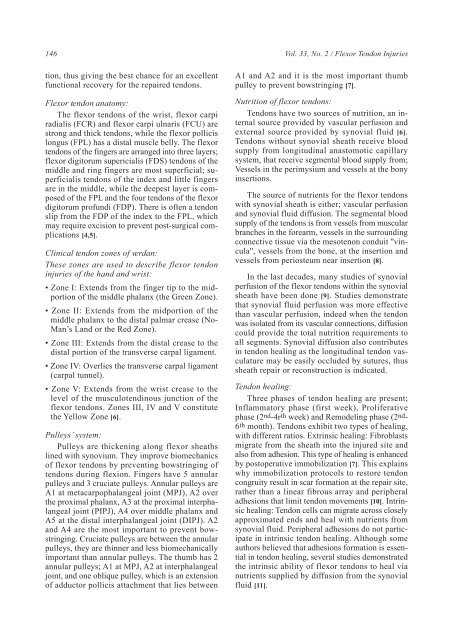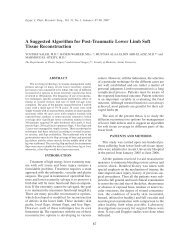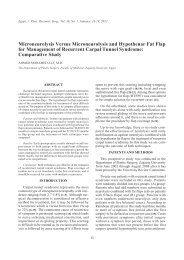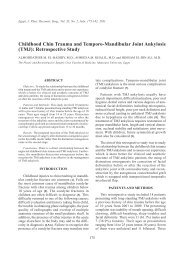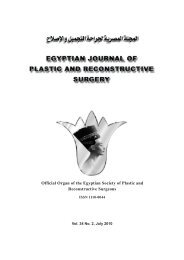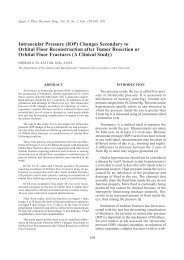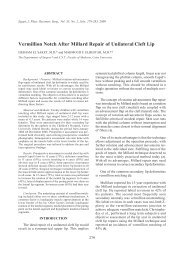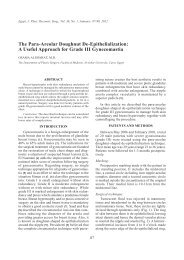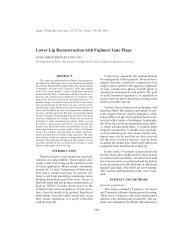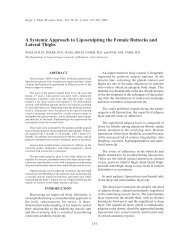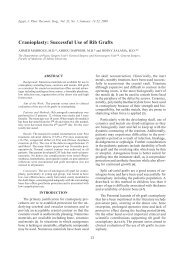Flexor Tendon Injuries: A Protocol Based on Factors that ... - ESPRS
Flexor Tendon Injuries: A Protocol Based on Factors that ... - ESPRS
Flexor Tendon Injuries: A Protocol Based on Factors that ... - ESPRS
Create successful ePaper yourself
Turn your PDF publications into a flip-book with our unique Google optimized e-Paper software.
146 Vol. 33, No. 2 / <str<strong>on</strong>g>Flexor</str<strong>on</strong>g> <str<strong>on</strong>g>Tend<strong>on</strong></str<strong>on</strong>g> <str<strong>on</strong>g>Injuries</str<strong>on</strong>g><br />
ti<strong>on</strong>, thus giving the best chance for an excellent<br />
functi<strong>on</strong>al recovery for the repaired tend<strong>on</strong>s.<br />
<str<strong>on</strong>g>Flexor</str<strong>on</strong>g> tend<strong>on</strong> anatomy:<br />
The flexor tend<strong>on</strong>s of the wrist, flexor carpi<br />
radialis (FCR) and flexor carpi ulnaris (FCU) are<br />
str<strong>on</strong>g and thick tend<strong>on</strong>s, while the flexor pollicis<br />
l<strong>on</strong>gus (FPL) has a distal muscle belly. The flexor<br />
tend<strong>on</strong>s of the fingers are arranged into three layers;<br />
flexor digitorum supericialis (FDS) tend<strong>on</strong>s of the<br />
middle and ring fingers are most superficial; superficialis<br />
tend<strong>on</strong>s of the index and little fingers<br />
are in the middle, while the deepest layer is composed<br />
of the FPL and the four tend<strong>on</strong>s of the flexor<br />
digitorum profundi (FDP). There is often a tend<strong>on</strong><br />
slip from the FDP of the index to the FPL, which<br />
may require excisi<strong>on</strong> to prevent post-surgical complicati<strong>on</strong>s<br />
[4,5].<br />
Clinical tend<strong>on</strong> z<strong>on</strong>es of verdan:<br />
These z<strong>on</strong>es are used to describe flexor tend<strong>on</strong><br />
injuries of the hand and wrist:<br />
• Z<strong>on</strong>e I: Extends from the finger tip to the midporti<strong>on</strong><br />
of the middle phalanx (the Green Z<strong>on</strong>e).<br />
• Z<strong>on</strong>e II: Extends from the midporti<strong>on</strong> of the<br />
middle phalanx to the distal palmar crease (No-<br />
Man’s Land or the Red Z<strong>on</strong>e).<br />
• Z<strong>on</strong>e III: Extends from the distal crease to the<br />
distal porti<strong>on</strong> of the transverse carpal ligament.<br />
• Z<strong>on</strong>e IV: Overlies the transverse carpal ligament<br />
(carpal tunnel).<br />
• Z<strong>on</strong>e V: Extends from the wrist crease to the<br />
level of the musculotendinous juncti<strong>on</strong> of the<br />
flexor tend<strong>on</strong>s. Z<strong>on</strong>es III, IV and V c<strong>on</strong>stitute<br />
the Yellow Z<strong>on</strong>e [6].<br />
Pulleys’ system:<br />
Pulleys are thickening al<strong>on</strong>g flexor sheaths<br />
lined with synovium. They improve biomechanics<br />
of flexor tend<strong>on</strong>s by preventing bowstringing of<br />
tend<strong>on</strong>s during flexi<strong>on</strong>. Fingers have 5 annular<br />
pulleys and 3 cruciate pulleys. Annular pulleys are<br />
A1 at metacarpophalangeal joint (MPJ), A2 over<br />
the proximal phalanx, A3 at the proximal interphalangeal<br />
joint (PIPJ), A4 over middle phalanx and<br />
A5 at the distal interphalangeal joint (DIPJ). A2<br />
and A4 are the most important to prevent bowstringing.<br />
Cruciate pulleys are between the annular<br />
pulleys, they are thinner and less biomechanically<br />
important than annular pulleys. The thumb has 2<br />
annular pulleys; A1 at MPJ, A2 at interphalangeal<br />
joint, and <strong>on</strong>e oblique pulley, which is an extensi<strong>on</strong><br />
of adductor pollicis attachment <strong>that</strong> lies between<br />
A1 and A2 and it is the most important thumb<br />
pulley to prevent bowstringing [7].<br />
Nutriti<strong>on</strong> of flexor tend<strong>on</strong>s:<br />
<str<strong>on</strong>g>Tend<strong>on</strong></str<strong>on</strong>g>s have two sources of nutriti<strong>on</strong>, an internal<br />
source provided by vascular perfusi<strong>on</strong> and<br />
external source provided by synovial fluid [6].<br />
<str<strong>on</strong>g>Tend<strong>on</strong></str<strong>on</strong>g>s without synovial sheath receive blood<br />
supply from l<strong>on</strong>gitudinal anastomotic capillary<br />
system, <strong>that</strong> receive segmental blood supply from;<br />
Vessels in the perimysium and vessels at the b<strong>on</strong>y<br />
inserti<strong>on</strong>s.<br />
The source of nutrients for the flexor tend<strong>on</strong>s<br />
with synovial sheath is either; vascular perfusi<strong>on</strong><br />
and synovial fluid diffusi<strong>on</strong>. The segmental blood<br />
supply of the tend<strong>on</strong>s is from vessels from muscular<br />
branches in the forearm, vessels in the surrounding<br />
c<strong>on</strong>nective tissue via the mesoten<strong>on</strong> c<strong>on</strong>duit ''vincula'',<br />
vessels from the b<strong>on</strong>e, at the inserti<strong>on</strong> and<br />
vessels from periosteum near inserti<strong>on</strong> [8].<br />
In the last decades, many studies of synovial<br />
perfusi<strong>on</strong> of the flexor tend<strong>on</strong>s within the synovial<br />
sheath have been d<strong>on</strong>e [9]. Studies dem<strong>on</strong>strate<br />
<strong>that</strong> synovial fluid perfusi<strong>on</strong> was more effective<br />
than vascular perfusi<strong>on</strong>, indeed when the tend<strong>on</strong><br />
was isolated from its vascular c<strong>on</strong>necti<strong>on</strong>s, diffusi<strong>on</strong><br />
could provide the total nutriti<strong>on</strong> requirements to<br />
all segments. Synovial diffusi<strong>on</strong> also c<strong>on</strong>tributes<br />
in tend<strong>on</strong> healing as the l<strong>on</strong>gitudinal tend<strong>on</strong> vasculature<br />
may be easily occluded by sutures, thus<br />
sheath repair or rec<strong>on</strong>structi<strong>on</strong> is indicated.<br />
<str<strong>on</strong>g>Tend<strong>on</strong></str<strong>on</strong>g> healing:<br />
Three phases of tend<strong>on</strong> healing are present;<br />
Inflammatory phase (first week), Proliferative<br />
phase (2 nd-4r th week) and Remodeling phase (2 nd-<br />
6 th m<strong>on</strong>th). <str<strong>on</strong>g>Tend<strong>on</strong></str<strong>on</strong>g>s exhibit two types of healing,<br />
with different ratios. Extrinsic healing: Fibroblasts<br />
migrate from the sheath into the injured site and<br />
also from adhesi<strong>on</strong>. This type of healing is enhanced<br />
by postoperative immobilizati<strong>on</strong> [7]. This explains<br />
why immobilizati<strong>on</strong> protocols to restore tend<strong>on</strong><br />
c<strong>on</strong>gruity result in scar formati<strong>on</strong> at the repair site,<br />
rather than a linear fibrous array and peripheral<br />
adhesi<strong>on</strong>s <strong>that</strong> limit tend<strong>on</strong> movements [10]. Intrinsic<br />
healing: <str<strong>on</strong>g>Tend<strong>on</strong></str<strong>on</strong>g> cells can migrate across closely<br />
approximated ends and heal with nutrients from<br />
synovial fluid. Peripheral adhesi<strong>on</strong>s do not participate<br />
in intrinsic tend<strong>on</strong> healing. Although some<br />
authors believed <strong>that</strong> adhesi<strong>on</strong>s formati<strong>on</strong> is essential<br />
in tend<strong>on</strong> healing, several studies dem<strong>on</strong>strated<br />
the intrinsic ability of flexor tend<strong>on</strong>s to heal via<br />
nutrients supplied by diffusi<strong>on</strong> from the synovial<br />
fluid [11].


